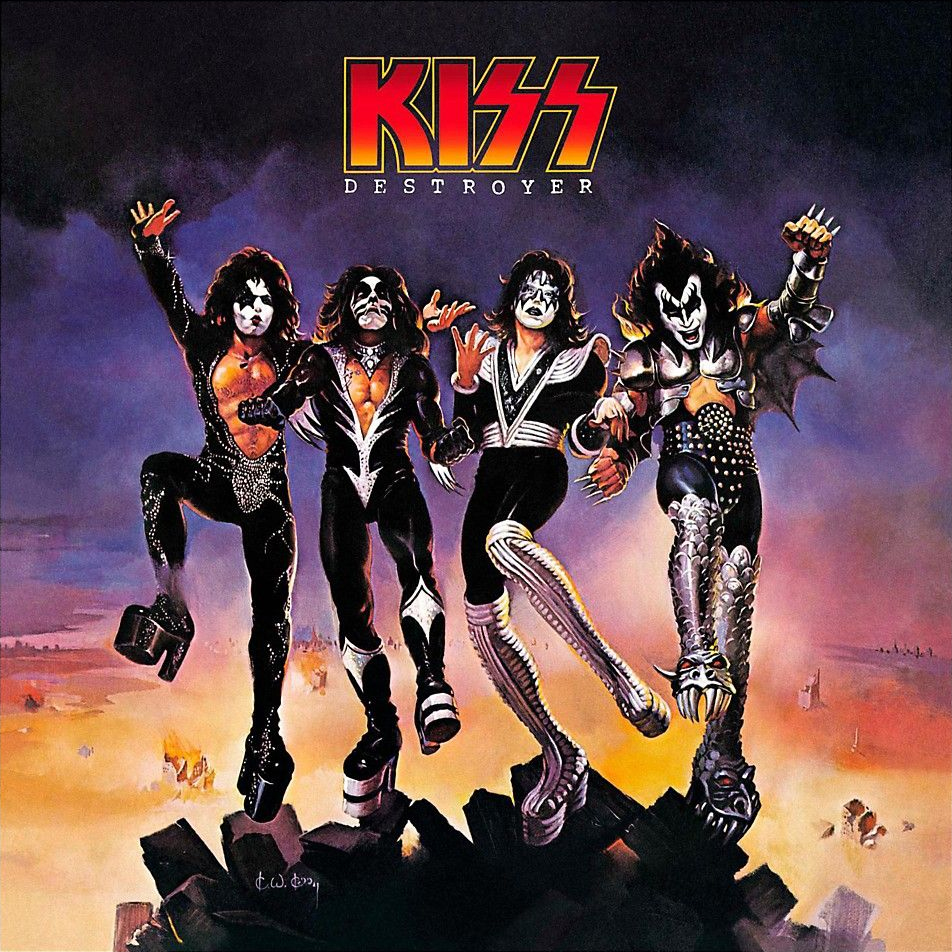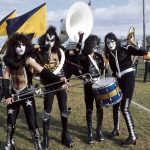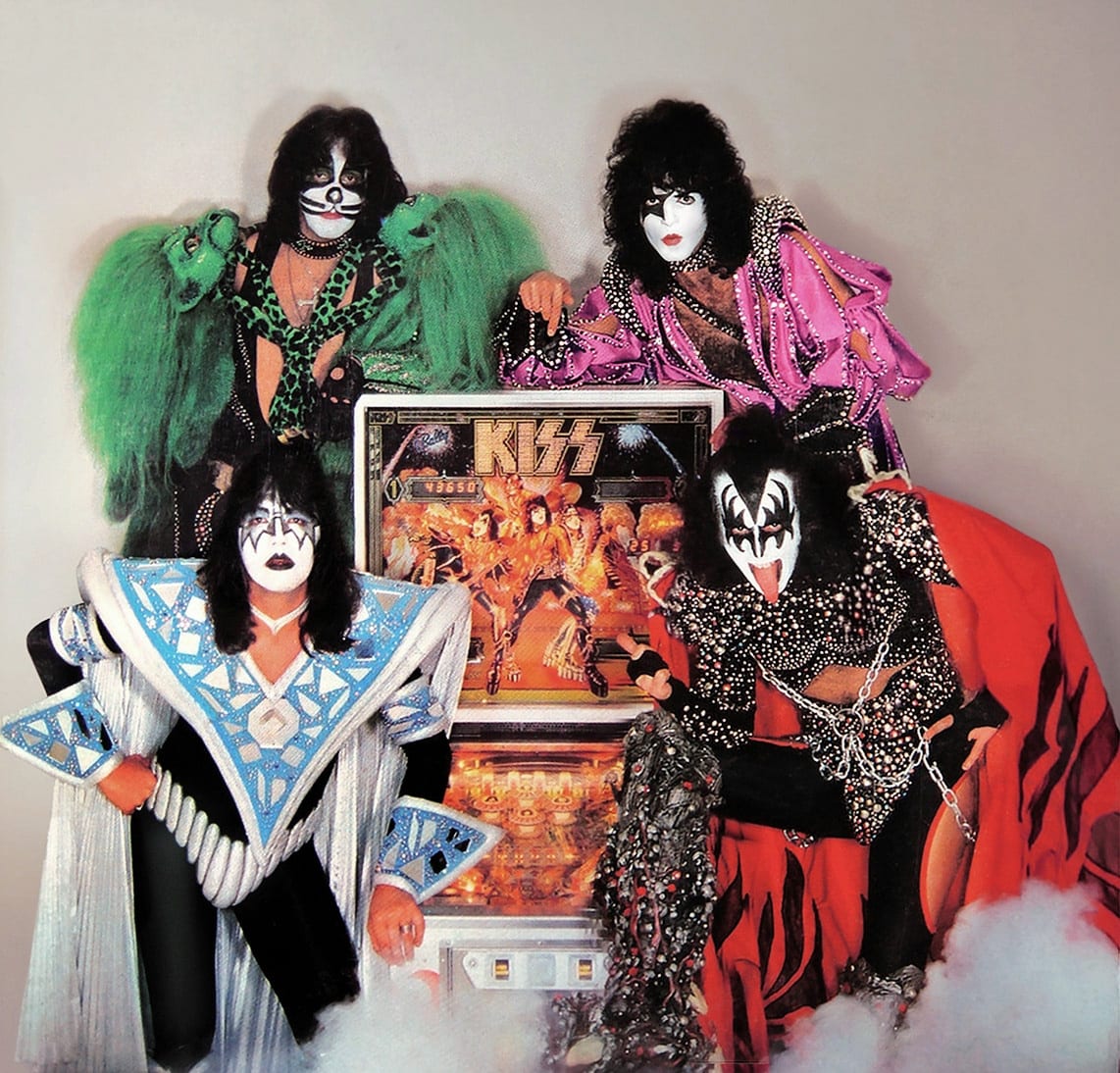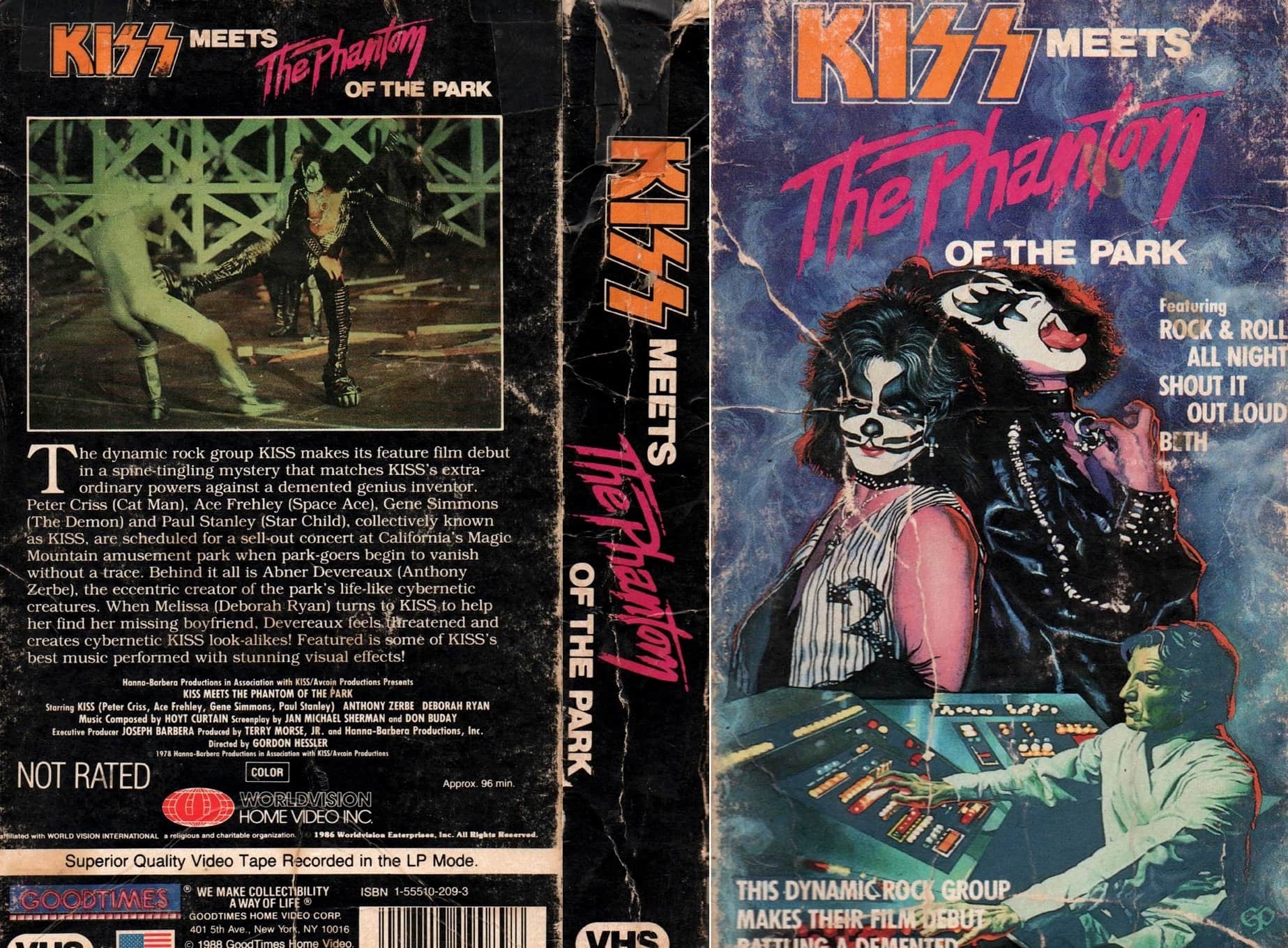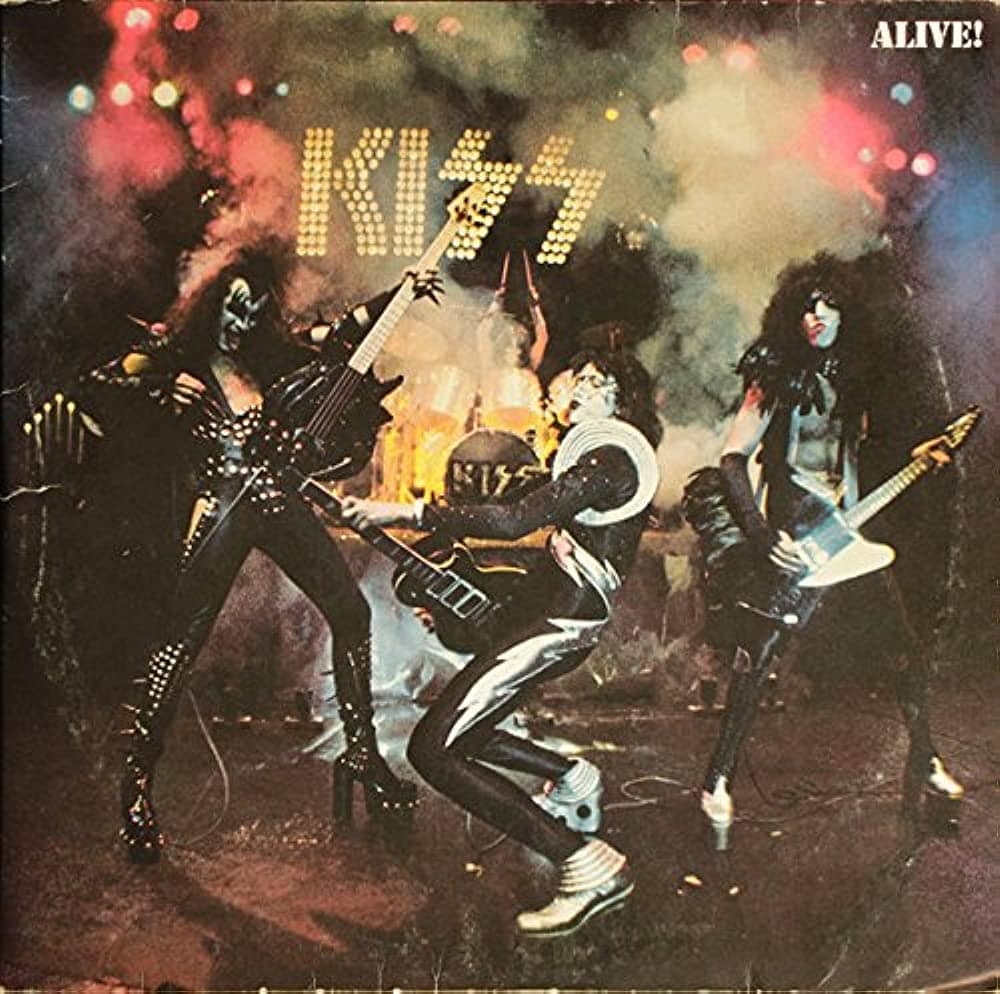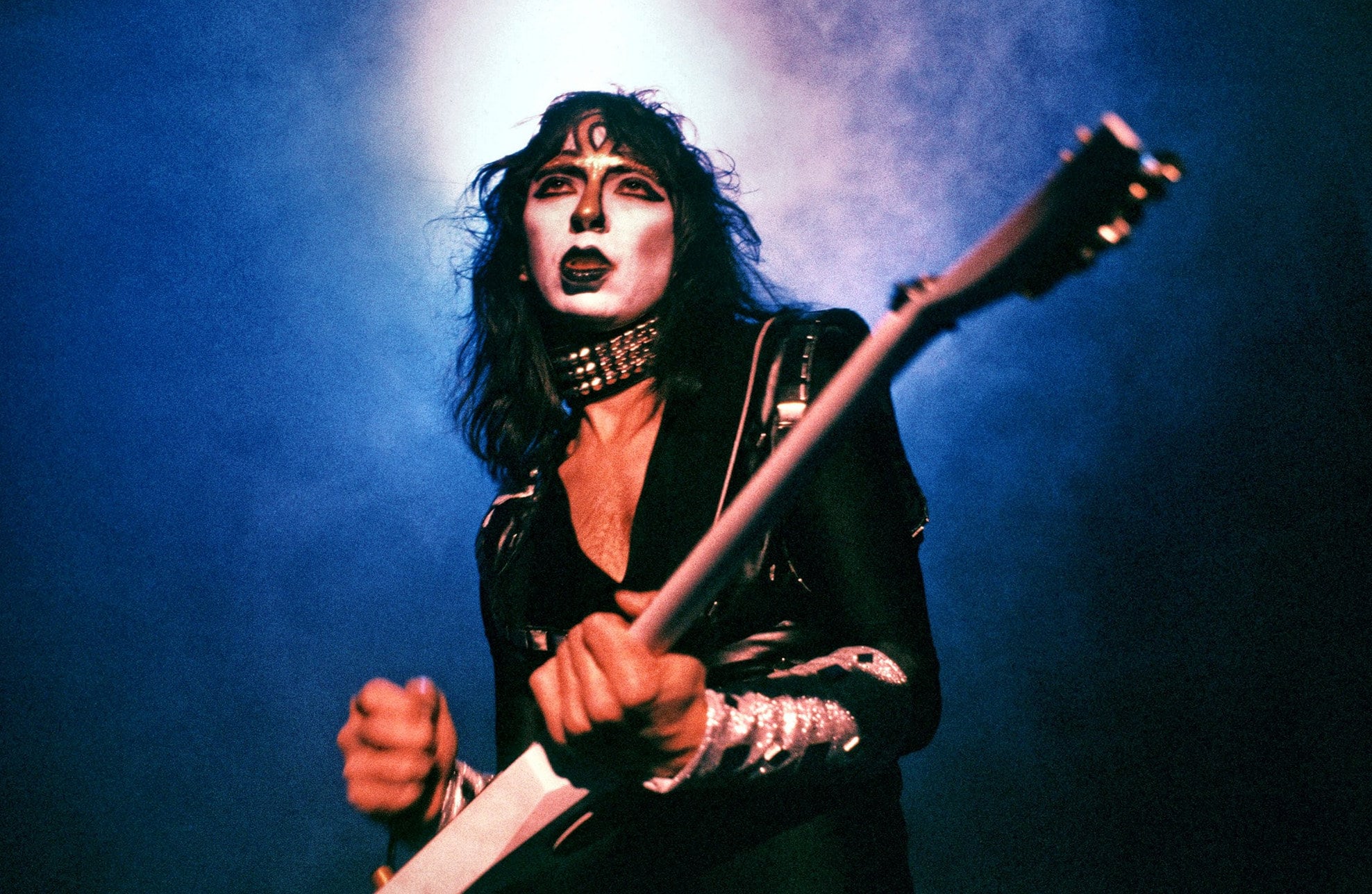On 15. March 1976, Kiss released their fourth album, “Destroyer”. It was the third successive Kiss album to reach the top 40 in the US, as well as the first to chart in Germany and New Zealand. The album was certified gold by the RIAA on April 22, 1976, and platinum on November 11 of the same year, the first Kiss album to achieve platinum. The album marked a departure from the raw sound of the band’s first three albums.
Ken Kelly’s original version of the album cover was rejected by the record company because they felt the scene was too violent looking with the rubble and flames. Also, the original version had the members of Kiss wearing the “Alive!” costumes. The front cover shows the group striding on top of a pile of rubble, and a desolate background spotted with destroyed buildings, some of which are engulfed in flames. The back cover shows a similar scene, but with more buildings on fire. The front of the inner sleeve featured a large Kiss logo and the lyrics to “Detroit Rock City”. The other side displayed the lyric “Shout It Out Loud”, as well as an advertisement for the Kiss Army fan club.
Paul Stanley:
“I wrote specifically to capture the essence of what we had done. Not recreating or making a retro album, not trying to make an album that sounded like it was recorded twenty years ago. It was more about capturing and rekindling the spirit of the band. The thing I always loved about Destroyer is it pushed the envelope and pushed the parameters of what we could do. It pushed us to the limit and yet everything stayed true to us because it was all comfortable, there was nothing forced or contrived. The idea with this album at least from my point of view is to make sure that we weren’t restricted with what we could be but were open to do anything as long as it was comfortable.”
– “Nothin’ to lose: The making of KISS (1972-1975)” by Ken Sharp
Gene Simmons:
“It was a different world. We didn’t know what we were getting ourselves into. Alive! was kind of a bookend of what we had done up until that time. We thought it was time to take a step forward. We didn’t want to do it ourselves because we thought we were too close to it so that’s why Bob Ezrin came in. And actually the combination worked really well because he has much more of a classical background than we do, so “Beth” kind of happened. He co-wrote that with Peter although Peter doesn’t really play an instrument. He just had this melody in his mind. Ezrin absolutely had his own way of recording things. He half engineered that record anyway. I don’t think we had a sense of anything [of how special the record was]. In fact we were scared some things sounded too different. We were very concerned about “Beth.” I’d give Destroyer four and a half stars.”
– “Nothin’ to lose: The making of KISS (1972-1975)” by Ken Sharp
Peter Criss:
“Oh fuck, Destroyer gets five stars! God, I worked so hard on it. At the time I actually went to a primal therapy institute where John Lennon went because I went so far into it that I totally lost all reality. Then I was getting introduced to coke and there was a lot of it. I got so engulfed in that shit on Destroyer, so into the songs. Of all the KISS albums that probably has my most brilliant drumming. It has my most unique drumming. I picked every part out. I planned every part, | wrote every part out. I never did this on any other album. “Do You Love Me?” is killer. Destroyer was a very difficult and hard album. “Beth” is on it. The album was failing. It was falling off the charts. It wasn’t making it. As far as I know some DJ picked it up and started playing “Beth.” And all of a sudden Neil Bogart starts going, “Wait a minute, they’re really playing this a lot.” All of a sudden, before you know it, he’s putting a lot of money behind it and they’re people out all over the field pushing “Beth.” Next, all of a sudden it’s number one and I’m winning a People’s Choice Award and fuck, the album goes double Platinum [laughs]. It was like, what happened? We were really sweating it like crazy. We were going, “Is this going to work? Did we do the right thing?” We used Bob Ezrin and no one is better than that. We spent a fortune to do it and we were really sweating when we saw it going down in Bil/board. We started going, “Oh no, Jesus Ch rist.” After all the primal therapy I went through I said, “This can’t happen.” But one snowy night around the holidays, Bill Aucoin dropped by my brownstone apartment and we had a fire going. We all sat around the couch and Bill said, “Listen to this.” And he put “Beth” on and it was real quiet. It was an incredible moment. We listened to it and all of a sudden we looked at each other and went, “Fuck, that’s good. That’s really magical.” Then when it was done playing Bill said, “Guess what? The album’s got a bullet again and it’s doing great. This is going to be the hit off the album.” We just all dropped dead. I remember it was such a beautiful moment. We had all these candles lit. It was just wild, I’ll never forget it.”
– “Nothin’ to lose: The making of KISS (1972-1975)” by Ken Sharp
Ace Frehley:
“It’s long been a suggested that studio guitar players were brought in to help out on Destroyer, filing in for me on the days when I simply wasn’t there. Well, the truth is that it happened a few times. I can’t deny it. Most of the guitar work on Destroyer is mine, but not all of it. I was hitting the clubs a lot at night in those days, living the life of a rock star. Sometimes that lifestyle wasn’t particularly conducive to making a record. I was starting to get out of control, but I probably would have been a lot more cognizant, and I would have showed up more and been on time, if I had gotten more encouragement from Gene, Paul, and Bob. But it wasn’t my record. In fact, of all the KISS records to that point, Destroyer felt the least like my record. It belonged more to Paul and Gene, and to Bob.”
– “No regrets” by Ace Frehley


